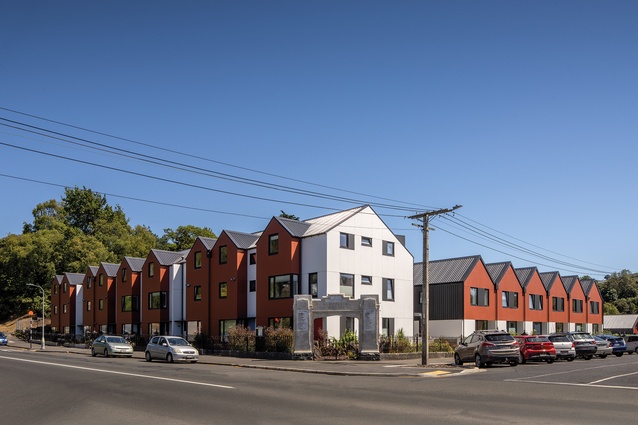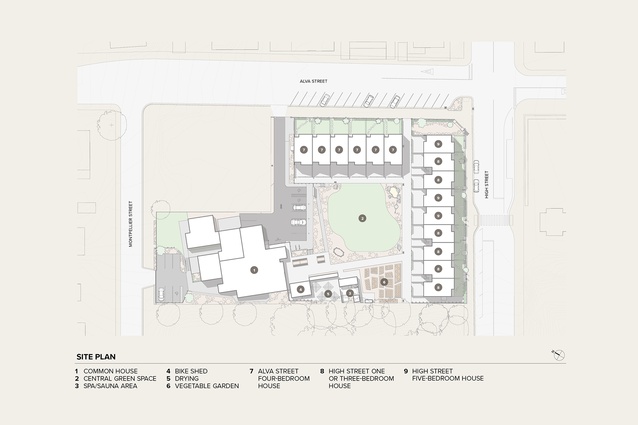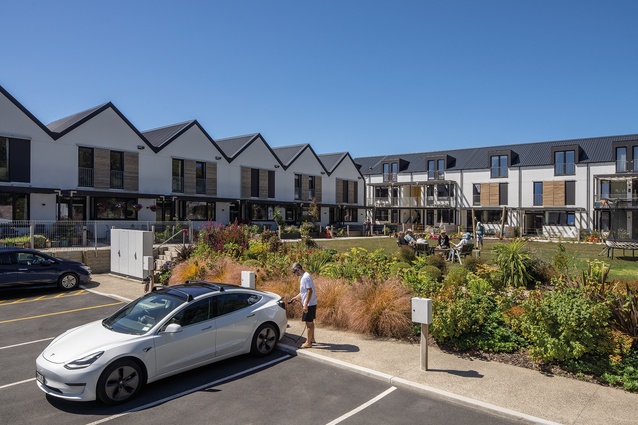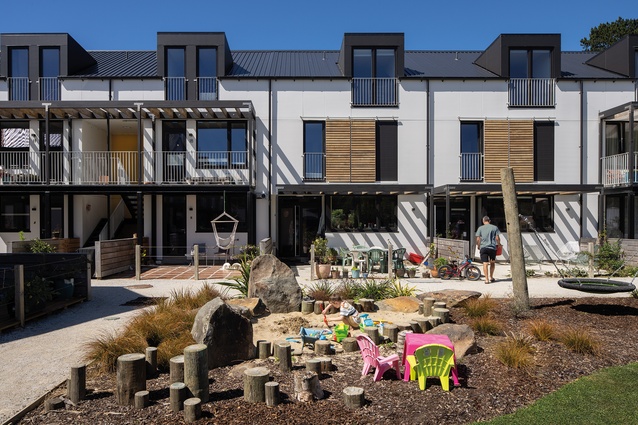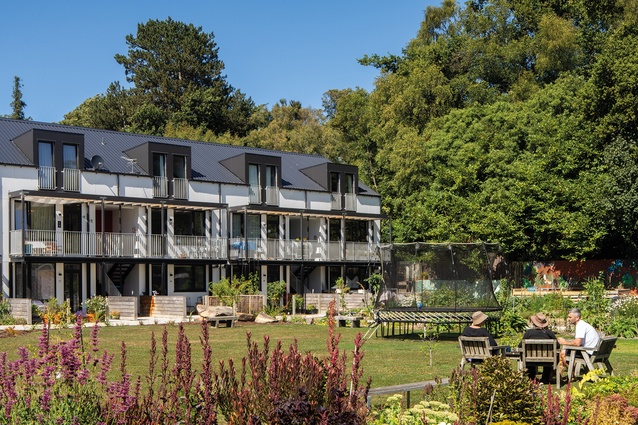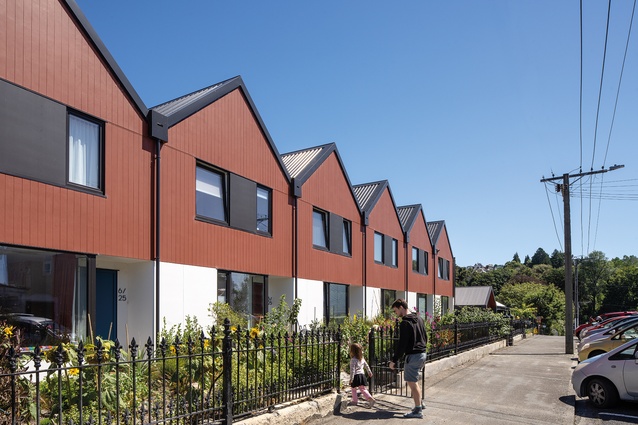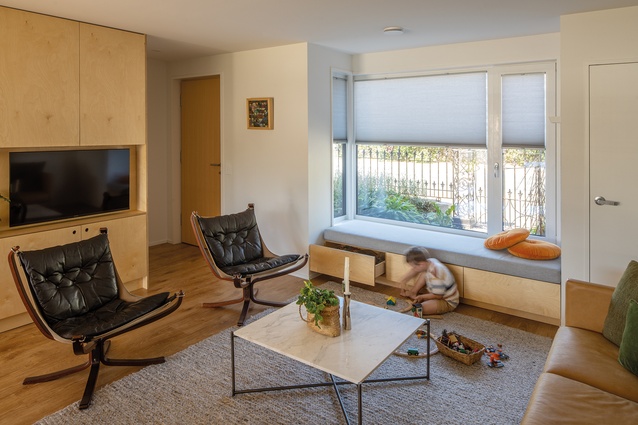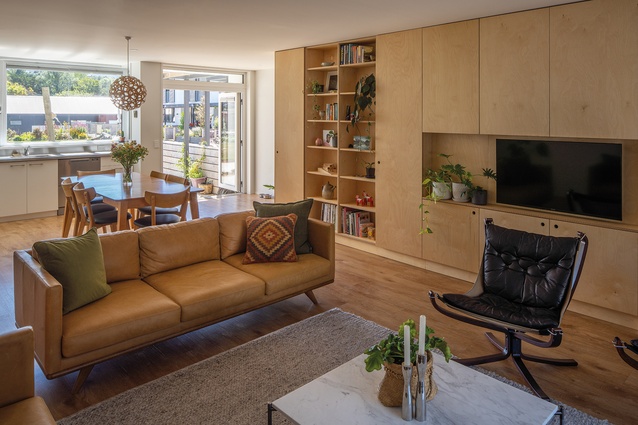Green commons
John Walsh visits the Toiora High Street Cohousing project in Ōtepoti Dunedin, by Architype, and finds a connection to a timeless tradition of shared space.
If the history of house-building in Aotearoa tells us anything, it’s that doing things differently is difficult. Builders are as attached to precedent as judges and banks are suspicious of any deviation from individualised lending and ownership norms. It takes uncommon persistence and resourcefulness to circumvent the obstacles blocking the adoption of new construction technologies and the realisation of communal housing initiatives. It’s not surprising that, here, the Melbourne-based Nightingale not-for-profit apartment-building model which, among other things, has liberated itself from the marketing impost levied by the real estate ‘industry’, remains as tantalisingly out of reach as a legendary desert oasis. (Nightingale retains its power to excite the design imagination, however, as it offers the shimmering prospect of architect-led development.) There have been, though, successful attempts to bypass this country’s traditional routes of housing procurement (outside, that is, of state or iwi/whānau programmes such as Kāinga Ora or papakainga housing).
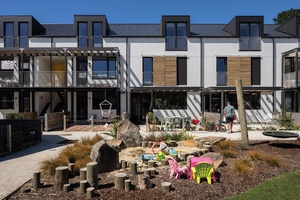
In Tāmaki Makaurau Auckland, the 32-home Earthsong Eco-Neighbourhood at Rānui was developed over a dozen years from the mid-1990s — the community’s architect and driving force, Robin Allison, chronicled the project in Cohousing for Life (2020) — and the 20-unit Cohaus project in Grey Lynn was completed in 2021. (The development was reviewed by Christopher Kelly in Architecture NZ, Nov/Dec 2021; responses to his commentary by the project’s architects Thom Gill and Helle Westergaard, and by Lisa Webb, are published on the ArchitectureNow website.) In Te Whanganui-a-Tara Wellington, Spacecraft’s Block Party, a four-dwelling co-housing project at Island Bay, was finished last year — an optimistic coda to the earlier inflation-induced cancellation of a 22-unit communal housing development in Newtown, designed by the same firm.
The insurgency against the status quo that funnels would-be home-owners into the comfort zone of the capital lenders (these are our terms) and development companies (these are your options) has also broken out in Ōtepoti Dunedin. Close to the city centre, a group of clients has worked for eight years alongside, for much of that time, Tim Ross, director of local practice Architype, to develop and then inhabit Toiora, a mini-village of 24 homes ranging from one to five bedrooms in size. Ross himself has demonstrated no shortage of commitment to the project — he and his family own a five-bedroom Toiora house. Toiora — the te reo term translates as ‘well-being’ — doubly dissents from housing business-as-usual. Not only does the project embody co-housing habitation principles but it also meets the audited standards of Passive House construction. Twice over, then, Toiora justifies the promise of its name.
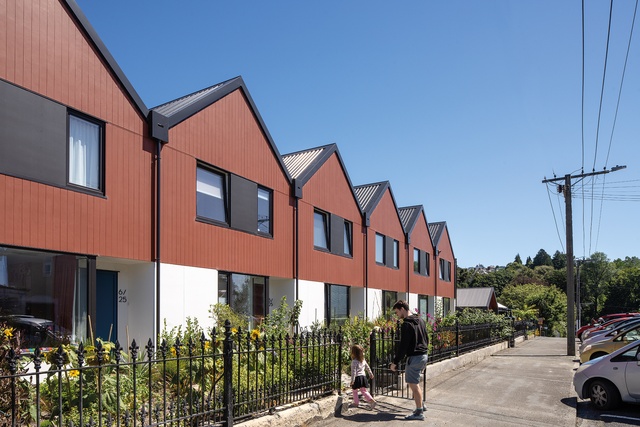
Toiroa occupies a 5000m2 site comprising most of the rectangular block bounded by High, Alva and Montpellier Streets, to the south, east and north respectively, with Queens Drive and the mature trees of the town belt to the west. It’s a very desirable plot of land — flat, elevated and about as sunny as it’s possible to be in a hilly, oceanic city lying on the polar side of the 45th parallel. The site was formerly occupied by High Street School, a public primary school which was established in 1887 and closed by the Ministry of Education in 2011 after its roll, 500-strong in the 1920s, had declined to fewer than 30 students.
Artefacts from the school’s history survive at Toiora, in accord with a heritage covenant placed upon sections of 1905 wrought-iron fencing and the 1926 war memorial and gate (Historic Place Category 2) at the corner of High and Alva Streets. Marble tablets on the Oamaru stone memorial record the names of 56(!) old boys who fatally answered the Empire’s call during the First World War.
When High Street School closed, ownership of its site passed to Kāi Tahu and thence to a group that had been looking for land for a co-housing development. The site had other suitors and, according to a Toiora source, it may be that Kāi Tahu was more sympathetic to the co-housing kaupapa. Which is what, exactly? Its prefix is an obvious indicator of joint endeavour but co-housing, a best-of-both-worlds merger of apartness and togetherness, seems to be more a matter of philosophy than prescription: an approach with common characteristics rather than mandatory criteria. This flexibility of definition allows co-housing initiatives considerable scope in finding a sweet spot of consensual communality on the spectrum between the introverted private house and the hippy collective. The latter association residually attaches to co-housing, despite the middle-class provenance of its adherents.

(In his review of Cohaus in Grey Lynn, Christopher Kelly struck a nerve by referring to the ‘commune aesthetic’ of the project’s landscaping; Sissinghurst redux was not the goal, the architects replied.) Under the planning regime current at the time of Toiora’s gestation, the development had to be notified; Tim Ross participated in public meetings held to assuage neighbours’ concerns about intensification and unease about a departure from suburban residential orthodoxy. In terms of building typology and scale, Toiora, in its context, is distinctive but hardly revolutionary. High Street, one of Dunedin’s notable character streets, has several stretches of joined-up houses on its lower reaches. (It accrues mansions as it ascends towards Mornington.) Toiora presents a terraced face to its main public edges: High Street, where the block of houses is three storeys high, and Alva Street, where a two-storey height plane allows morning sunlight to reach further into the interior garden, framed and sheltered by the buildings’ L-shape. North-side enclosure is provided by the old school hall, retained and repurposed for communal use.

The central garden, with its lawn, planted beds and playgrounds — there is a community vegetable patch, located at an aesthetically appropriate remove — is not just the organising principle of Toiora but also the most overt expression of its kaupapa. In a planning sense, the spatial capital saved by terraced construction has been expended on the commons, which constitutes about half of the site. The green is, literally, the focus of Toiora; both the small terraces of those houses with ground-level gardens and all the houses’ kitchens look out to it, and to the afternoon sun. In a benign exercise in social engineering, the usual domestic spatial dispensation is inverted and the houses’ more recessionary, or private, living areas are located on their street sides. The idea, says Ross, is to let residents — some are elderly, a few live alone — look at life. Toiora kids can enjoy some of the free roaming Ross remembers from his childhood in Paeroa — “we owned the town”.
Co-housing is a relatively recent phenomenon, the popularisation by, especially, American architects Kathryn McCamant and Charles Durrett of the 1960s’ Danish ‘living community’ (bofællesskab) concept.
There is, however, an echo in its organisation of a venerable social institution: the monastic foundation, which combines the seclusion of the individual cell and the communality of the refectory, chapel and garden. Of course, monks must submit to a rule, but co-housers get to choose from a menu of voluntary activities and communal amenities. Toiora residents can sign up for gardening duty and one Toiora statistic, in particular, is a riposte to suburbia’s material profligacy: households, 24, lawnmowers, one. There are shared meals in the hall and everyone has access to a community laundry, a well-equipped workshop and EV charging ports.

Cost saving, at a co-housing project, is probably a secondary benefit to community-building. It is more overtly a selling point of Passive House design, a complementary virtue to the provision of an environmentally comfortable home. Above an insulated concrete floor slab, Toiroa’s houses are framed in timber, selected over concrete and steel framing to reduce carbon footprint and heat loss through thermal bridging. (As a type, the terrace is inherently insulated in its sideways dimension.) External walls are constructed of Structural Insulated Panels — ‘sandwiches’ of board-faced foam — and clad in fibre cement. The Europe-sourced windows are triple-glazed — if there’s one phrase that makes Dunedinites go weak at the knees, it’s ‘triple-glazing’ — and houses are equipped with heat-recovery ventilation systems, maintaining a stable base temperature of 20 degrees. (One resident of a single-bedroom unit says her monthly utilities bill is less than $25.) At a future date, solar panels may be installed on Toiora’s north-facing roofs.

Toiora’s houses, which had a 2019–2020 build cost of $2650+GST per square metre (excluding, that is, professional and council fees, and the costs of common facilities and site development), were constructed as modules. These were variously configured and sized, according to client demand, across levels but on the same footprint. The buildings’ impressive level of resolution, which extends to built-in ply shelving and storage, is testament to Architype’s commitment and evidence of Tim Ross’ experience, which includes employment at Architectus and leading UK multi-housing and sustainable design practice Feilden Clegg Bradley Studios. It certainly takes skill and determination but different, as Toiora demonstrates, is doable.


